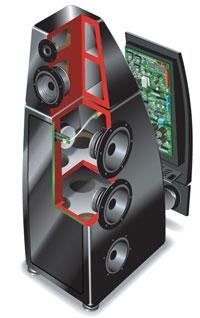Inner Workings: Inside an Active Speaker

| Click image for larger view |
Active speakers have several other advantages. In most A/V systems, a signal source - sometimes analog but increasingly digital - is fed into a preamp/processor or a receiver. An analog signal might be converted to digital for manipulation, then converted back to analog before being sent to an amp as a line-level signal. (Digital signals are also generally converted to analog inside the preamp.) Once amplified, the now high-level audio signal is sent to the speakers (often via long cable runs), where a passive crossover uses a series of filters to split the signal into the frequency bands required by the different types of drivers (woofers, midranges, and tweeters).
But in an active speaker, electronic crossovers create the separate frequency bands early in the signal chain - most important, before amplification. This can allow the signal to remain in pure digital form farther down the signal path. And there are no long cable runs from the amp to the speaker, which can introduce noise or interference. Also, since the frequencies are allocated before amplification, separate amps can be used to power each band, and crossover components can be chosen based on audio performance without consideration of their ability to withstand high levels of power.
The one thing they aren't, though, is common. Still, several well-regarded manufacturers, including Bang & Olufsen (in its BeoLab series), Meridian (DSP-series models), and NHT (the Xd system), offer active speakers that boast excellent performance, albeit at fairly steep prices.
Meridian's current statement in active-speaker design is its flagship DSP8000. The striking-looking speaker comprises two cabinets. The sealed higher-frequency upper enclosure houses a horn-loaded aluminum-dome tweeter with a silver voice coil and a polymer-cone midrange driver (with a phase plug instead of a dust cap). The larger bass cabinet holds six side-firing, long-throw, 8-inch plastic-cone woofers, which are vertically aligned (three per side) and horizontally opposed, to reduce cabinet resonance. The cabinets are made of curved, pressure-laminated panels (a sandwich of Russian Birch plywood and aluminum-alloy sheets) and are finished in a high-gloss piano-black lacquer.
- Log in or register to post comments



































































